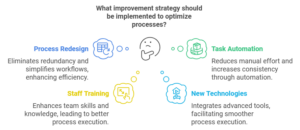Unlock the power of your processes with Atlassian System of Work
With Atlassian System of Work, and its tools like Jira, Confluence, and Bitbucket, you have a complete ecosystem for managing projects and collaborating. But are you getting the most out of these tools? Process optimization is crucial for improving the efficiency and effectiveness of any work system. In the case of Atlassian System of Work, which focuses on collaboration and productivity, process optimization can be achieved through a combination of strategies and tools.
Process Optimization in Atlassian System of Work
Here is a step-by-step approach to applying process optimization in Atlassian’s System of Work:
1. Identifying key processes
Start by identifying the key processes that will be analysed. This could include processes such as project management, software development, IT service management, or any other essential workflow for the company. It is important to select processes that have a significant impact on the overall performance of the organization.
2. Extracting relevant data
Once the processes have been identified, it is necessary to extract the relevant data from the Atlassian tools used to execute them. This involves accessing event logs from Jira, Confluence, Bitbucket, Jira Service Management, etc.
A process optimization tool, such as Process Analytics for Jira, is used to extract and transform existing process data that will lead to generate valuable information about the actual behavior of the processes.
3. Data analysis and process modelling:
With the data obtained and using a specialized process mining tool, you will be able to:

- Discover how your processes really work. Visually reconstruct the workflow from the data.
- Identify bottlenecks and areas for improvement. Detect where delays, loops, or deviations from the ideal process occur.
- Determine compliance by compare the generated process model with your ideal process, so you can evaluate the impact of deviations.
- Perform simulations and predictions. Evaluate the impact of proposed improvements, or anticipate process behaviour in response to changes in the context.
- Use Atlassian Teamwork Graph to get a holistic view of processes. Connect the critical elements of teamwork (teams, objectives, work, and knowledge) and obtain valuable information for optimization.
4. Design and implementation of improvements:
With the information obtained from the analysis, improvements to the processes are designed and implemented. Improvements may include:

5. Monitoring and continuous improvement:
Consequently, it is crucial to monitor their impact and make adjustments, if necessary, once the improvements have been implemented.
Process mining tools and the Teamwork Graph can be used to supervise the performance of the process over time, detecting new inefficiencies or deviations.
Additionally, these tools can help evaluate the effectiveness of implemented improvements by verifying whether optimization objectives have been met. Furthermore, they can identify opportunities for continuous improvement, recognizing that the optimization process is iterative and must adapt to changes in the business environment.
Final considerations
By optimizing processes, teams can work smarter and achieve better results with less effort, leading to increased efficiency and productivity. In addition, costs can be significantly reduced by eliminating inefficiencies, reducing errors and optimizing the use of resources.
To guarantee successful process optimization, it is vital to involve end users at every stage of the process. Effective communication and change management are essential for a seamless implementation. Process optimization should be regarded as an ongoing endeavour, adapting to the evolving needs of the organization.
Remember, process optimization in Atlassian System of Work is not just about implementing tools, but about adopting a holistic approach that combines technology, people, and processes to achieve operational excellence.